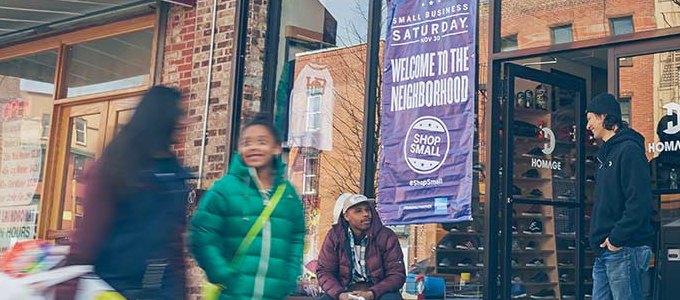
The credit card company’s chief diversity officer discusses how the organization’s LGBT diversity and inclusion practices cross over to one of its biggest initiatives: Small Business Saturday.
by Kate Everson
June 5, 2015
Small Business Saturday started in 2010 and has since become a Congress-endorsed, presidentially promoted event. (Photo courtesy of American Express Co.)
The credit card company famous for the slogan “Don’t leave home without it” treats its LGBT inclusionary practices the same way — no program leaves the office without them.
In 2010, the company started Small Business Saturday, an annual event that takes place the day after Black Friday and promotes supporting local and independent retailers by encouraging card users to “Shop Small.” Last year, the company held the first “Small Business Saturday Night,” which included after-dark events in Chicago, San Francisco and New York City. The latter featured speakers and a performance by singer and LGBT advocate Mary Lambert.
According to the 2014 Small Business Saturday Consumer Insights Survey, Americans spent $14.2 billion at independent retailers and restaurants during last year’s event, up from 2013’s $14 billion. This in part was due to increased public awareness — President Obama endorsed it, 450 cities and 40 states issued promotional proclamations and the U.S. Senate unanimously passed a resolution that designated November 29, 2014, as Small Business Saturday.

But what the public might not be aware of is how the event echoes the year-round work that American Express has been doing within its company to support LGBT employees.
Chief diversity officer Valerie Grillo spoke with Diversity Executive about how internal practices met external initiatives to create a day that benefits clients, business owners and the company’s own bottom line. Edited excerpts follow.
What are your internal practices for LGBT employees, and how did they become part of American Express’ Small Business Saturday?
The Pride Network is celebrating its 20th anniversary in 2015. It has about 10 chapters now across the world. Employee networks are a big part of our culture. About 40 percent of employees are part of one of our networks that focus on building community, providing career guidance, as well as growing the company. We know from our data that individuals who are part of an employee network are more engaged than employees not in network. They really can help drive employee engagement and the bottom line.
A couple years ago, Pride was wondering how to help the bottom line. At that point, our Shop Small initiative was big and had taken off. They created Shop Small, Shop Proud, which demonstrates that we have an inclusive brand and that we want to broaden our customer base. So they started helping with our Shop Small initiative and showing Amex’s ongoing support as LGBT community.
What kind of role has social media and public outreach had in achieving American Express’ goals?
It’s really important that individuals know that Amex is inclusive. We pride ourselves on that. We want our employee base to mirror our customer base. Being open about how we’re going beyond merchants and card members helps to reinforce that inclusivity as a key part of our brand.
One example is we started the hashtag, #ExpressYourSelfie. When individuals can engage with our brand, we can get the word out.
From the experience of rolling out this program and doing so much work with employee networks, what advice do you have for other diversity leaders?
The employee networks really thrive when they’re for the people by the people. At Amex, we provide overall structure — they need to be focused on growing the company, building careers of membership and building a community across company — but we really let networks drive their own initiatives and agenda. That’s how the Shop Small initiative got off the ground.
Make sure that as you build employee networks that there’s senior leader support. They (the networks) are driven by employees, but encouraged, coached and advised by senior leadership of the company. That helps provide them direction, and that’s a big value.
We believe that innovation’s going to come internally from us by having a diverse employee base. That’s what impacts our bottom line and translates into better products.



